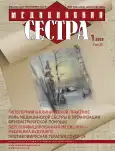Modern medical-diagnostic and organizational technologies for the management of children with infections of the urinary system
- Авторлар: Grigoriev K.I.1
-
Мекемелер:
- Pirogov Russian National Research Medical University
- Шығарылым: Том 25, № 1 (2023)
- Беттер: 12-20
- Бөлім: Profession: theory and practice
- URL: https://journal-vniispk.ru/0025-8342/article/view/143247
- DOI: https://doi.org/10.29296/25879979-2023-01-02
- ID: 143247
Дәйексөз келтіру
Аннотация
The article presents information about infections of the urinary system in children, their description, diagnosis, visualization of changes in the kidneys by instrumental methods, clinical symptoms, possible complications, principles of treatment, taking into account the characteristics of antibiotic therapy, and the role of a nurse in disease prevention. The need for continuous monitoring of the sensitivity of the isolated urine flora to antibiotics in each region and the development of modern clinical guidelines for the diagnosis and treatment of urinary tract infections in children, based on a rational approach, taking into account the changing sensitivity of uropathogens to antibacterial drugs, are emphasized.
Негізгі сөздер
Толық мәтін
##article.viewOnOriginalSite##Авторлар туралы
Konstantin Grigoriev
Pirogov Russian National Research Medical University
Хат алмасуға жауапты Автор.
Email: k-i-grigoryev@yandex.ru
Scopus Author ID: 56848239000
Doctor of Medical Sciences, Professor Department of Pediatrics with Infectious Diseases in Children, Faculty of Additional Professional Education
Ресей, MoscowӘдебиет тізімі
- Baranov A.A., Kozlov R.S., Namazova-Baranova L.S., Andreeva I.V. et al. Urinary tract infection in children: clinical guidelines - 2021-2023. Approved by the Ministry of Health of the Russian Federation 10.11.2021. http://gbpokachi.ru/upload/ edialibrary/2f2/emzta4l9 jatnvwmdqzgvziynsj8wo2.pdf.
- Melnikova E.A., Luchaninova V.N., Krukovich E.V., et al. Difficulties and possibilities of diagnosis of urinary system infection in neonates. Pediatrics. Journal im. G.N. Speransky, 2017; 96 (5): 8-14.
- Korovina N.A., Zakharova I.N., Mumladze E.B., et al. Diagnosis and treatment of pyelonephritis in children: a manual for physicians. M.: Medpraktika-M: 2007: 44.
- Paediatric nephrology: a guide for doctors. Ed. by M.S. Ignatova. 3rd ed. M.: MIA, 2011: 696.
- Chugunova OL, Shumikhina MV Urinary system infection in children: current issues. Effective pharmacotherapy. Pediatrics. 2015; 22 (3): 10-16.
- Van Batavia JP, Combs AJ, Fast AM, Glassberg KI. Overactive bladder: A symptom in search of a disease - Its relationship to specific lower urinary tract symptoms and conditions. J Pediatr Urol. 2017;13(3):277.e1-277.e4. doi: 10.1016/j.jpurol.2017.02.010.
- Maidannik V.G., Kovalchuk I.V. Modern aspects of pyelonephritis in children. International Journal of Pediatrics Obstetrics Gynecology. 2016; 9 (3): 17-22.
- Gofrit O. N., Shapiro A., Rund D., et al. Thrombocytosis accompanying urinary tract infection suggests obstruction or abscess. American Journal of Emergency Medicine. 2006; 24: 118-121.
- Liao PF, Ku MS, Tsai JD, et al. Comparison of procalcitonin and different guidelines for first febrile urinary tract infection in children by imaging. Pediatr Nephrol, 2014; 29 (9):1,567-574. doi: 10.1007/s00467-014-2801-z.
- Zakharova I.N., Osmanov I.M., Mumladze E.B., et al. Asymptomatic bacteriuria: changing the conventional view. Medical Advice. In Children’s Polyclinic. 2017; 9: 162-167.
- Stein R, Dogan HS, Hoebeke P, et al. European Association of Urology. European Society for Pediatric Urology. Urinary tract infections in children: EAU/ESPU guidelines. Eur Urol, 2015; 67 (3): 546-558.
- Delyagin V.M., Ismailova I., Gorbylev P. Diagnosis of urinary tract infections in infants. Physician, 2017; 8: 78-81.
- Obrycki L, Sarnecki J, Lichosik M, et al. Kidney length normative values - new percentiles by age and body surface area in Central European children and adolescents. Pediatr Nephrol. 2022 Aug 8. doi: 10.1007/s00467-022-05667-2.
- Bakradze M.D., Zorkin S.N., Zelikovich E.I., et al. Complicated forms of pyelonephritis in children. Pediatric pharmacology. 2013; 10 (2): 92-99.
- Shaikh N, Spingarn RB, Hum SW. Dimercaptosuccinic acid scan or ultrasound in screening for vesicoureteral reflux among children with urinary tract infections. Cochrane Database Syst Rev. 2016; 5;7(7): CD010657. doi: 10.1002/14651858.CD010657. pub2
- Vyalkova AA, Gritsenko VA Urinary system infection in children: current aspects of etiological diagnosis and treatment. Ros vestn perinatol i pediatr, 2017; 62: (1): 99-108. doi: 10.21508/1027-4065-2017-62-1-99-108.
- Palagin I.S., Sukhorukova M.V., Dehnich A.V., et al. Antibiotic resistance of non-hospital urinary tract pathogens in Russia: results of DARMIS-2018 multicenter study and the DARMIS-2018 study group. KMAH. 2019; 21 (2): 134-146.
- Kozlovsky A.A. Urinary tract infection in children: a modern view of the problem. Medical News, 2014. no. 4: 6-11.
- Grigoryev K.I. Infections of the urinary system organs in young children. Nursing, 2018; 20 (6): 21-29. https:// doi. org/10.29296/25879979-2018-06-05
- Desai DJ, Gilbert B, McBride CA. Paediatric urinary tract infections: Diagnosis and treatment. Aust Fam Physician, 2016; 45 (8): 558-563.
- Bogdanova N.A., Kirillov V.I., Serebrovskaya N.B., et al. The principle of minimum sufficiency as an alternative to antibacterial chemopreparations in the treatment of uncomplicated urinary tract infections in pediatric practice. Ros vestn perinatol i pediatr. 2022; 67: (4): 286.
- Morozov S.L., Dlin V.V. Pyelonephritis in children. A modern view of the problem. Praktika pediatr, 2020; No. 1: 32-37.
- Karavanaki KA, Soldatou A, Koufadaki AM, Tsentidis C, Haliotis FA, Stefanidis CJ. Delayed treatment of the first febrile urinary tract infection in early childhood increased the risk of renal scarring. Acta Paediatr, 2017;106(1):149-154. doi: 10.1111/ apa.13636.
Қосымша файлдар









